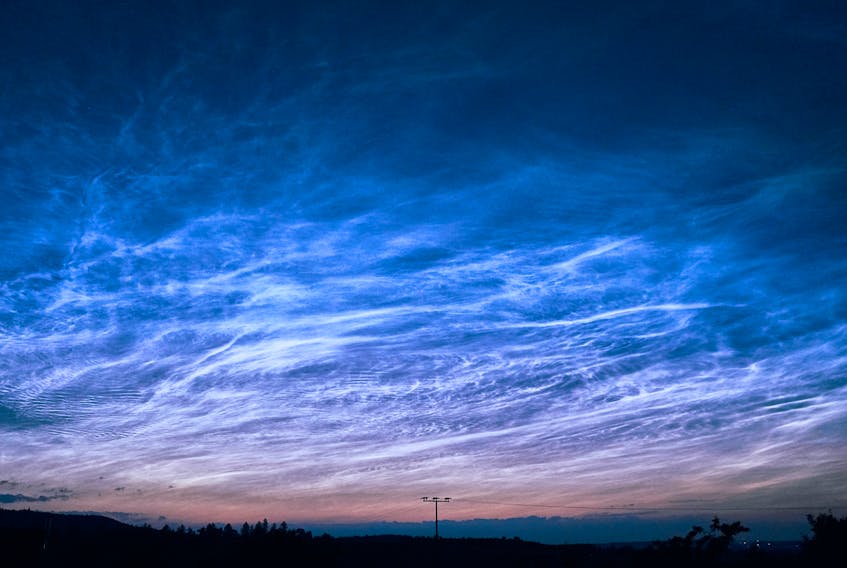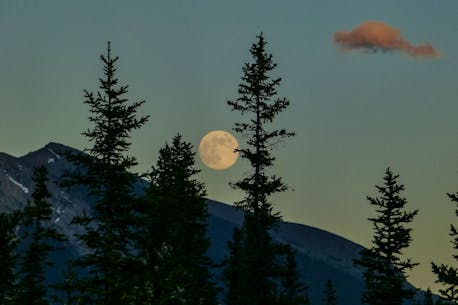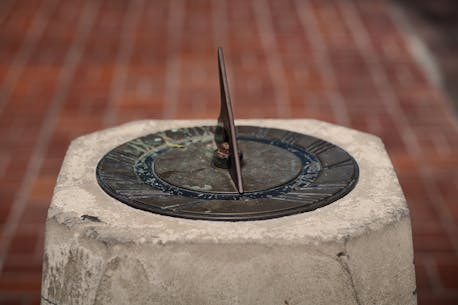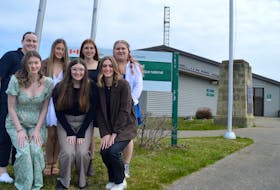Have you ever wondered what those faint, ethereal lights high up in the late evening western or pre-dawn eastern sky are?
They are noctilucent clouds, the highest clouds in the sky. From the Latin nocto (night) and lucent (shining), these night-shining clouds are thin clouds high in the Earth's mesosphere, one of our planet's five principle atmospheric levels.
The troposphere is the atmospheric layer closest to Earth's surface (extending up to about 12 kilometres above sea level). Above it lies the stratosphere (12-50 kilometres above sea level), followed by the mesosphere (50-80 kilometres above sea level), the thermosphere (80-700 kilometres above sea level) and, finally, the exosphere (700-10,000 kilometres) above sea level, the uppermost atmospheric level.
The upper and lower boundaries of the mesosphere vary with latitude and season, with the lower boundary usually between 50-65 kilometres above sea level and the upper boundary sometimes reaching between 85-100 kilometres above sea level.
Noctilucent clouds only form in the mesosphere and only during the Northern Hemisphere's late spring/early summer months (mid-May to mid-August), when the temperatures in the mesosphere are at their coldest (as low as -134 C). Due to the dynamics of the Earth's atmosphere, the coldest temperatures tend to occur in the polar regions of the Northern Hemisphere in the summer months at the height of the mesosphere.

Noctilucent clouds can only form in the presence of water vapour, dust particles from meteors and extremely cold temperatures. The clouds themselves consist of tiny ice crystals which form when the water vapour present in the mesosphere condenses around the dust particles, although research has demonstrated that, under the right conditions, the ice crystals may be able to form directly from water vapour if the temperature is cold enough.
During the Northern Hemisphere's summer months, air near the Earth's surface becomes heated and rises into the atmosphere. As atmospheric pressure decreases with altitude, the rising air expands and cools. This, along with other atmospheric processes, forces the air even higher, until it reaches the mesosphere. There, with the right combination of water vapour, dust and cold temperatures, ice crystals form. Light from the setting or rising sun illuminates the ice crystals from below, making them appear as whitish or pale blue (the blue colour is the result of the absorption by ozone in the path of the sunlight illuminating the ice crystals) wisps, streaks or swirls in the late-evening or predawn sky.
The World Meteorological Organization recognizes four major forms (which can be subdivided) of noctilucent clouds: Type I — long, very tenuous veils, having a well-defined structure; Type II — bands or streaks in roughly parallel, widely spaced groups; Type III — billowy arrangements of closely-spaced, roughly parallel, short streaks that closely resemble cirrus clouds; and Type IV — whirls that are partial or, more rarely, complete rings of clouds with dark centers.
Noctilucent clouds are only visible during astronomical twilight (see last week's article), either just after sunset or just before dawn, and are best seen when the geocentric center of the sun is between six and 16 degrees below the horizon. During these time periods, any clouds in the Earth's lower atmosphere will be darkened by the Earth's shadow (the shadow that our planet itself casts through its atmosphere out into space); only the very high noctilucent clouds — if present — will still be in sunlight. The presence of noctilucent clouds also varies with latitude and, although usually seen at latitudes between +/- 50 to +/-70 degrees, they have been recorded at lower latitudes; in 2019, they were seen in Las Vegas (+36N latitude) and Los Angeles (+34N latitude).
Observational history
Although noctilucent clouds were, no doubt, present in the atmosphere, there is no confirmed mention of them before 1885, two years after the infamous Krakatoa volcanic eruption in the Sundra Strait between the Java Sea in Indonesia and the Indian Ocean from May 20 - Oct. 21, 1883. It is thought that the beautiful sunrises and sunsets around the globe in the years that followed Krakatoa's eruption, which spewed millions of tonnes of water vapour and fine volcanic dust into Earth's atmosphere, sparked increased interest in atmospheric sciences.
The term noctilucent clouds was first used by the German astronomer Otto Jesse (1838-1901), who, in 1887, was the first person known to have photographed these clouds. It was theorized, at that time, that noctilucent clouds, like the colourful sunrises and sunsets, were the direct result of the fine volcanic dust injected into the upper atmosphere by Krakatoa. However, it soon became obvious that the clouds could not be caused solely by the volcanic dust, as they continued to be seen long after the dust from Krakatoa had finally settled and this theory was disproved in 1926.
Alfred Lothar Wegner (1880 - 1930), a German climatologist, geophysicist, meteorologist and polar researcher was the first to theorize that noctilucent clouds were composed primarily of water-ice in the 1920s.

Interest in noctilucent clouds seems to have waned after that until the 1960s, when research from rocket launch measurements demonstrated a clear link between noctilucent clouds and the very low temperatures in Earth's mesosphere layer.
Noctilucent clouds, when studied from space, are referred to as polar mesosphere clouds or PMCs. PMCs were first detected from space by NASA's Orbiting Geophysical Observatory in 1972. From 1981-‘86, NASA's Solar Mesosphere Explorer satellite mapped the distribution of PMCs around the world.
The first direct physical confirmation of PMCs came in 2001, with data from the Halogen Occultation Experiment instrument aboard NASA's Upper Atmosphere Research Satellite orbital observatory. Sweden's Odin satellite, launched in 2001, produced daily maps showing the distribution patterns of PMCs around the globe. NASA's Aeronomy of Ice in the Mesosphere satellite, launched on April 25, 2007 and still in use, was the first satellite dedicated solely to the study of PMCs.
While the frequency of noctilucent clouds normally varies from year to year due to changes in the Earth's atmosphere and the sun's solar cycle, they are becoming increasingly common in both hemispheres.
Current PMC research is centred on the contribution of past and current space launches (in particular, the huge amounts of water vapour these launches inject into the upper atmosphere) might be having on the formation and frequency of PMCs.
Researchers are also looking at the impacts associated with climate change and rising greenhouse gas emissions, most notably methane (which, through oxidization and other chemical interactions, produces water vapour within the troposphere, which then rises into the mesosphere). Studies show that between 1871-2008, global methane emissions more than doubled the amount of mesospheric ice, thereby increasing noctilucent cloud formation. Scientific data from 2022 indicates that the frequency of noctilucent clouds formation globally was the highest it has been in the past 15 years, perhaps demonstrating a possible link to both increased space launches and rising greenhouse gas emission levels.
In the sky this week
- Venus (mag. -4.5, in Leo — the Lion) is visible around 9:25 p.m., 12 degrees above the western horizon as darkness falls, before sinking towards the horizon and setting by about 11:45 p.m.
- Mars (mag. +1.7, in Leo), though now receding further into the evening twilight, may be observable to the upper left of Venus.
- Saturn (mag. +0.8, in Aquarius — the Water Bearer) becomes accessible around 12:30 a.m., when it is 11 degrees above the southeast horizon. It reaches its highest point of 33 degrees above the southern horizon around 4:35 a.m. before becoming lost in the dawn twilight around 4:40 a.m.
- Jupiter (mag. -2.2, in Aries — the Ram) rises in the east-northeast around 1:40 a.m., reaching 35 degrees above the eastern horizon, before fading into the approaching dawn shortly after 5 a.m. Watch the waning moon slide past Jupiter in the eastern, pre-dawn sky.
- Mercury (-1.5, in Gemini — the Twins), though climbing higher in the evening sky this month, is not readily observable this week, reaching only about one degree above the western horizon at dusk on July 10, and six degrees by the 16th.
Events
- July 10: Last quarter moon
- July 11/12: Waning moon near Jupiter; east, pre-dawn
- July 13: Waning crescent moon below Pleiades star cluster; east, pre-dawn
- July 15/16: Look for earthshine on thin, waning crescent moon; east, pre-dawn
Glenn K. Roberts lives in Stratford, P.E.I., and has been an avid amateur astronomer since he was a small child. He welcomes comments from readers at [email protected].












